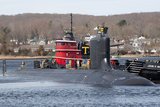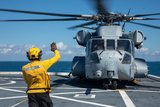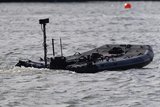USNS John Lewis to return to active service following PSA
Built by General Dynamics NASSCO, USNS John Lewis was launched in January 2021 and commissioned in July 2022. (Photo: General Dynamics NASSCO/US Navy)
US Navy replenishment oiler USNS John Lewis (TAO-205), part of the MSC fleet of support ships and the lead ship of her class, will return to active service following the completion of a Post-Shakedown Availability (PSA) by Pacific Northwest-base shipyard operator Vigor.
The work was carried out over an eight-month period at Swan Island in Oregon and began in the second half of 2023. The availability focused on systems improvements and post-delivery upgrades to improve the vessel’s operability. More than 200 skilled workers supported work on the oiler.
According to Shephard Defence Insight, the US Navy has planned to replace 15 legacy TAO-187-class navy fleet-replenishment oilers with 20 TAO-205 vessels. USNS John Lewis, namesake of its class, was commissioned in July 2022 and was equipped with a NIXIE Torpedo Countermeasure System and Advanced Degaussing System (Anti-Mine) to protect against magnetically fused sea mines.
Adam Beck, EVP of ship repair for Vigor, remarked: “Completing John Lewis represents a milestone as we head into a new class of vessel. These availabilities not only ensure we maintain a strong fleet, they support hundreds of family wage jobs in Portland and all around the Pacific Northwest.”
USNS Henry J. Kaiser, namesake of the previous generation of replenishment oilers, has also been undergoing an availability at Vigor’s Swan Island shipyard. Vigor has also been carrying out work to two more oilers, USNS Mercy and USNS Washington Chambers.
Related Programmes in Defence Insight
Light Replenishment Oiler (T-AOL) [USN]
Related Equipment in Defence Insight
More from Naval Warfare
-
![Hanwha wins Australian government approval to increase its stake in Austal]()
Hanwha wins Australian government approval to increase its stake in Austal
The contract would mean the two shipbuilders can collaborate strategically and enhance shipbuilding capabilities in Western Australia.
-
![UK to join US Navy’s Virginia-class submarine assembly effort to speed up construction]()
UK to join US Navy’s Virginia-class submarine assembly effort to speed up construction
The expansion of the Virginia-class submarine construction to UK shores could accelerate the project as US shipbuilders continue to fall short of delivery goals.
-
![US Navy seeks new sensors for the CH-53K King Stallion heavy-lift helicopter]()
US Navy seeks new sensors for the CH-53K King Stallion heavy-lift helicopter
The US Navy intends to publish a draft request for proposals in Q2 2026 and conduct an open competition for the supply of new electro-optical and infrared capabilities for the CH-53K heavy-lift helicopter.
-
![NATO naval exercises map out future USV requirements but raise questions on acquisition]()
NATO naval exercises map out future USV requirements but raise questions on acquisition
Uncrewed surface vessels have shifted from a desirable capability to a critical one for navies. But should these systems be bought outright, rented as a service or rapidly built using commercial off-the-shelf components?






















